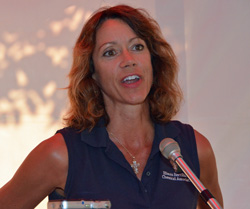 Having lots of data is good for precision farming, but that data has to meet certain standards for it to mean anything consistently for users on the other end. That’s why the 2013 InfoAg Conference on precision agriculture addressed the subject with Jim Wilson, Standards Director, for Ag Gateway, a non-profit organization that looks to promote, enable and expand e-business in agriculture. One of their big projects is SPADE – the Standardized Precision Agricultural Data Exchange Program.
Having lots of data is good for precision farming, but that data has to meet certain standards for it to mean anything consistently for users on the other end. That’s why the 2013 InfoAg Conference on precision agriculture addressed the subject with Jim Wilson, Standards Director, for Ag Gateway, a non-profit organization that looks to promote, enable and expand e-business in agriculture. One of their big projects is SPADE – the Standardized Precision Agricultural Data Exchange Program.
“One of the activities within that project was to define the requirements for data flowing from farm management information systems to other farm management information systems and farm management information systems to controllers on equipment and back,” he said. Standards for data already existed, but the Ag Gateway project team identified gaps between that standard and what was needed. Feedback has been sent to the ISO committee, and they’re working on figuring out how to implement changes.
Jim said Phase 1 of SPADE focused on seeding information, with Phase 2 expected to build on that, as well as looking at infrastructure and getting into harvest elements. He added that things are a bit open-ended at this point with an undetermined number of phases still ahead of them.
“Each phase has its own deliverables. The absolute end game of all of SPADE is not clear. We’re just taking steps to improve parts of the process. So if we can get controllers and farm management information systems talking more effectively with one another and then a farmer’s system talking with an agronomist’s system more effectively, those are steps in the right direction,” he said.
Jim invites people who are interested in attending this November’s Ag Gateway meeting in St. Petersburg, Fla.
You can listen to Chuck’s interview with Jim here: [wpaudio url=”http://zimmcomm.biz/infoag/infoag-13-ag-gateway-jim-wilson.mp3″ text=”Interview with Jim Wilson, Standards Director, Ag Gateway”]









 Here is the next in our series as we introduce you to a few of dedicated precision ag equipment dealers in a series called “Getting to Know Ag Leader”.
Here is the next in our series as we introduce you to a few of dedicated precision ag equipment dealers in a series called “Getting to Know Ag Leader”. 
